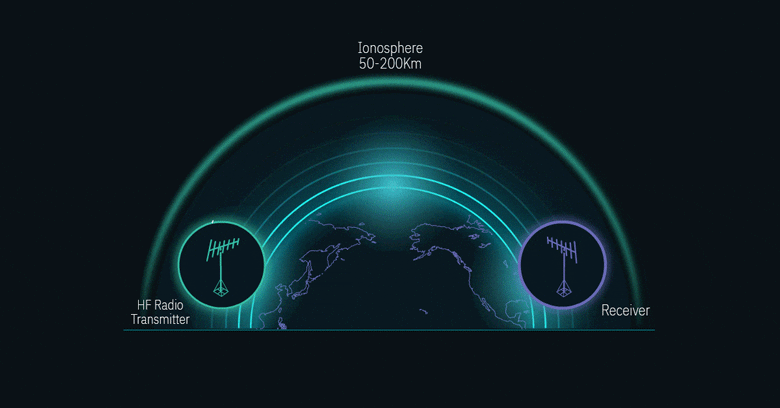Delivering a Stable Data Network Over HF Links
The sky is the limit
Many technological inventions and systems leverage physics, but the physics part is usually controlled and predictable. HF – High Frequency wireless radio-based networks, leveraging a 50% faster light speed through air than through glass, are reliant, in a very profound way, on a physical phenomenon that is difficult to control. When HF or Skywave signals travel between two distant antennas, they are carried and propagated back by the earth’s ionosphere layers. As a result, the sky becomes an integral part of the system (and the earth surface that the signal may “hop” onto and from along the way).
HF networks take the dependency on physics to a new level – whereby the “cable” is the sky, which plays a major role in shaping the path of a signal.

The ionosphere is ionized by the sun and made reflective to HF (3-30MHz) radio waves that bounce off randomly moving ions. In a nutshell, the ionosphere is comprised of layers and sub-layers (E,D,F), formed in various heights, changing with the sun’s ionization between day and night, following seasonal cycles, and are influenced by sunspot and other occasional solar events such as solar storms or solar flares.
Raft provides the fastest network available today. How is that made possible?
- High throughput (TP) rate - the percentage of successfully passing signals. TP is never 100% by design, as guaranteeing 100% would cost time.
- Service availability - guaranteed high TP rates during service hours.
- Minimizing detection errors
Consistently hitting the right frequency
While site selection and buildup play a key role in impacting the service performance, we’ll dedicate a separate post to the operational aspect and focus here on network management over established links.
As radio frequencies (and correlated signal wave lengths) differ in how they are propagated by layers of the ionosphere, careful frequencies selection is necessary. Frequency prediction tools are used to find a good starting point; a good choice is determined by factors such as route location, time of day and season (which affects daylight times, the sun’s distance, and location of known sunspots, for example).
The actual frequency to be used in each service day is determined based on the link’s historical performance. There are methods and tools for testing good frequencies, which include a cross check for detecting interferences – if a frequency is expected to perform well in the sky but shows interferences on the ground (receiving end), it’s obviously not good enough and the search for a frequency continues.
The performance is closely monitored during service hours. Effective frequencies can change momentarily and teams, as well as AI-based automatic systems that introduce that capability of the system to “improve itself” (more on that in the future) are constantly analyzing various sources, striving for the best performance possible.
Since HF links are used across long distances, the route may include alternating day/night zones (more so in the short days of winter) which differ in their ionosphere condition. The best frequency selected will be used on their entire route, hence methodologies that will result in many hours of good performance requires a high level of expertise.
Finally, the system should be capable of working with changing frequencies.
This is the challenge we face.
It’s why we are here, at Raft.
Pushing the limits, devising ways to be a bit faster, the fastest.

Increasing signal detection
Aside from finding the best frequencies for a given point in time “cable in the skies”, modulation methods, algorithms, and amplification address other issues:
- Interferences referred to as “man-made noise”
- Other HF transmissions (e.g., military communications) because the spread is wide and the travelled distances are long, some energy transmitted by others, may reach your receivers.
- Interferences on the receiving end can be caused by electrical devices, motors, or other sources of disturbing energy radiation. The signal-to-noise ratio is critical; as the distance increases, the more difficult it becomes. Algorithms provide resistance to both detected and unpredicted noise.
- Medium related, a bumpy path for a wave – because the propagating electromagnetic waves are reflected by many randomly moving ions, some waves may travel different paths, shifting signals in time and/or frequency, experiencing selective fading or absorption. These phenomena may cause signals to duplicate (aka multipath) and/or fade in ways that make message detection very complicated. Coping with this starts with smart design for shaping signal messages while optimizing use of the frequency band (a scarce resource) and transmission power and ends with the complex algorithms on the receiver side optimizing performance
Maintaining high KPIs
By now, you are probably starting to realize how complicated it is to sustain HF network stability. Sure, latency is the #1 KPI we look at, but extending serviceability day-long and year-round is a must and a major focus of ours.
Raft provides a fully managed end-to-end service that includes active network management.
Availability of more than 12 hours per day with TP greater than 80% is not rare on routes we master.